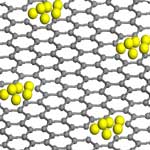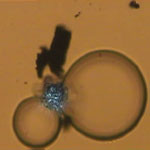Showing Spotlights 121 - 128 of 318 in category All (newest first):
 In a previous Nanowerk Spotlight we reported about work by a group of Chinese scientists that demonstrated that carbon nanotube sheets can act as powerful thermoacoustic loudspeakers. Moving experiments with carbon nanotube loudspeakers from air into water, researchers at the University of Texas at Dallas have now observed surprisingly high underwater sound generation efficiency using multi-walled carbon nanotubes sheets that are self-supported or attached to porous tissue. As a matter of fact, the nanotechnology speakers perform as well underwater as they do on land. The most surprising result they observed is that the carbon nanotubes immersed in water can still generate sound thermo-acoustically at frequencies 1 Hz - 100 KHz, despite the huge thermal capacity of water and its low thermal expansion.
In a previous Nanowerk Spotlight we reported about work by a group of Chinese scientists that demonstrated that carbon nanotube sheets can act as powerful thermoacoustic loudspeakers. Moving experiments with carbon nanotube loudspeakers from air into water, researchers at the University of Texas at Dallas have now observed surprisingly high underwater sound generation efficiency using multi-walled carbon nanotubes sheets that are self-supported or attached to porous tissue. As a matter of fact, the nanotechnology speakers perform as well underwater as they do on land. The most surprising result they observed is that the carbon nanotubes immersed in water can still generate sound thermo-acoustically at frequencies 1 Hz - 100 KHz, despite the huge thermal capacity of water and its low thermal expansion.
Jun 21st, 2010
 Flame retardant materials have become a major business for the chemical industry and can be found practically everywhere in modern society. Unfortunately, conventional methods for making plastic flame retardant involve a range of often very toxic chemicals. It has already been demonstrated that the flame retardancy of polymeric materials without the use of toxic chemicals could become possible thanks to the synergistic effect of nanoclay and carbon nanotubes. In a step further, researchers have now shown that the use of buckypaper is more efficient as a fire retardant in polymer composites in comparison to directly mixing carbon nanotubes into the composite matrix.
Flame retardant materials have become a major business for the chemical industry and can be found practically everywhere in modern society. Unfortunately, conventional methods for making plastic flame retardant involve a range of often very toxic chemicals. It has already been demonstrated that the flame retardancy of polymeric materials without the use of toxic chemicals could become possible thanks to the synergistic effect of nanoclay and carbon nanotubes. In a step further, researchers have now shown that the use of buckypaper is more efficient as a fire retardant in polymer composites in comparison to directly mixing carbon nanotubes into the composite matrix.
Jun 7th, 2010
 Among the various production methods for carbon nanotubes and graphene, currently only chemical vapor deposition techniques demonstrate a significant opportunity for mass production of CNT material. Using the CVD process, which is based on the catalytic action of metals, manufacturers can combine a metal catalyst such as iron with reaction gases such as hydrogen to form carbon nanotubes inside a high-temperature furnace. In order to optimize the synthesis process, a detailed understanding of the interaction between nanotubes or graphene and metal atoms is required - something that has been missing so far. Researchers in France have now shown that it is possible to create atomic-scale defects in carbon nanotubes and in graphene in preselected positions with a focused electron beam and to use these defects as trapping centers for foreign atoms.
Among the various production methods for carbon nanotubes and graphene, currently only chemical vapor deposition techniques demonstrate a significant opportunity for mass production of CNT material. Using the CVD process, which is based on the catalytic action of metals, manufacturers can combine a metal catalyst such as iron with reaction gases such as hydrogen to form carbon nanotubes inside a high-temperature furnace. In order to optimize the synthesis process, a detailed understanding of the interaction between nanotubes or graphene and metal atoms is required - something that has been missing so far. Researchers in France have now shown that it is possible to create atomic-scale defects in carbon nanotubes and in graphene in preselected positions with a focused electron beam and to use these defects as trapping centers for foreign atoms.
May 31st, 2010
 Carbon nanotubes' interesting structural, chemical, electrical, and optical properties are explored by numerous nanomedicine research groups around the world with the goal of drastically improving performance and efficacy of biological detection, imaging, and therapy applications. In many of these envisaged applications, CNTs would be deliberately injected or implanted in the body, for instance as intercellular molecular delivery vehicles. One of the issues researchers have been exploring is how - once the primary role of CNTs in a therapeutic application is fulfilled - they can promote the rapid removal of CNTs from the body, or the dispersal of aggregated clusters to sub-micron size in order to mitigate the harmful effects. Researchers in India have now demonstrated a novel, optical tweezers based approach to scavenge CNTs from biological fluids such as blood.
Carbon nanotubes' interesting structural, chemical, electrical, and optical properties are explored by numerous nanomedicine research groups around the world with the goal of drastically improving performance and efficacy of biological detection, imaging, and therapy applications. In many of these envisaged applications, CNTs would be deliberately injected or implanted in the body, for instance as intercellular molecular delivery vehicles. One of the issues researchers have been exploring is how - once the primary role of CNTs in a therapeutic application is fulfilled - they can promote the rapid removal of CNTs from the body, or the dispersal of aggregated clusters to sub-micron size in order to mitigate the harmful effects. Researchers in India have now demonstrated a novel, optical tweezers based approach to scavenge CNTs from biological fluids such as blood.
May 27th, 2010
 Electrically conductive composite materials capable of substantial elastic stretch and bending - conductive rubbers - is an industrially important field. The composites are needed for such applications as smart clothing, flexible displays, stretchable circuits, strain gauges, implantable devices, high-stroke microelectromechanical systems, and actuators. A variety of approaches involving carbon nanotubes and elastic polymers have been suggested for the fabrication of conductive elastic composites. Various studies indicated that high loading of CNTs or other conductive additives into the polymer was necessary to obtain a highly conducting composite. A research team has now demonstrated that a combination of high stretchability and high electrical conductivity can be obtained for composites prepared from three-dimensional CNT structures.
Electrically conductive composite materials capable of substantial elastic stretch and bending - conductive rubbers - is an industrially important field. The composites are needed for such applications as smart clothing, flexible displays, stretchable circuits, strain gauges, implantable devices, high-stroke microelectromechanical systems, and actuators. A variety of approaches involving carbon nanotubes and elastic polymers have been suggested for the fabrication of conductive elastic composites. Various studies indicated that high loading of CNTs or other conductive additives into the polymer was necessary to obtain a highly conducting composite. A research team has now demonstrated that a combination of high stretchability and high electrical conductivity can be obtained for composites prepared from three-dimensional CNT structures.
May 21st, 2010
 The development of artificial muscles is one of the key areas for bionic enhancements or replacements. The discovery of the electromechanical actuation properties of single-walled carbon nanotubes and the complex behavior of multi-walled carbon nanotubes has led to the development of various carbon nanotube actuators. Besides artificial muscles, potential applications include microelectro-mechanical systems (MEMS), biomimetic micro-and nanorobots, and micro fluidic devices. Recently, a new class of active system, carbon nanotube/polymer composite actuators, has received great attention with regard to macroscopic artificial muscle applications. It has been demonstrated that successful introduction of the highly conductive CNTs could significantly enhance the polymer nanocomposite's electrical, thermal, mechanical, and interface properties, thus providing a suitable material for novel artificial muscle-like actuator investigations.
The development of artificial muscles is one of the key areas for bionic enhancements or replacements. The discovery of the electromechanical actuation properties of single-walled carbon nanotubes and the complex behavior of multi-walled carbon nanotubes has led to the development of various carbon nanotube actuators. Besides artificial muscles, potential applications include microelectro-mechanical systems (MEMS), biomimetic micro-and nanorobots, and micro fluidic devices. Recently, a new class of active system, carbon nanotube/polymer composite actuators, has received great attention with regard to macroscopic artificial muscle applications. It has been demonstrated that successful introduction of the highly conductive CNTs could significantly enhance the polymer nanocomposite's electrical, thermal, mechanical, and interface properties, thus providing a suitable material for novel artificial muscle-like actuator investigations.
May 19th, 2010
 Graphene is being explored, among many other uses, as a replacement material for silicon in photonic devices to expand the wavelength range of operation and to improve performance. Another area where graphene potentially could replace silicon and could have a huge impact is as light-absorbing material in solar cells. Although it has been well known that graphene has very attractive properties for photovoltaic applications - tunable bandgap and large optical absorptivity - these advantages could not be exploited so far due to the problem of fabricating solution-processable, stable, and large enough, size-controllable graphene structures useful for charge collection in solar cells. Graphene quantum dots might offer a solution to these fabrication problems.
Graphene is being explored, among many other uses, as a replacement material for silicon in photonic devices to expand the wavelength range of operation and to improve performance. Another area where graphene potentially could replace silicon and could have a huge impact is as light-absorbing material in solar cells. Although it has been well known that graphene has very attractive properties for photovoltaic applications - tunable bandgap and large optical absorptivity - these advantages could not be exploited so far due to the problem of fabricating solution-processable, stable, and large enough, size-controllable graphene structures useful for charge collection in solar cells. Graphene quantum dots might offer a solution to these fabrication problems.
Apr 14th, 2010
 Few technologies on the near-term horizon offer as much potential for game-changing results as do carbon nanotube products. But in an age where the state-of-the-art in global defense, transportation and energy depend on meaningful advancement and delivery of novel materials, it is critical to view scalability to be as important as product performance itself. To date, few nanotechnology manufacturers have solved this scaling problem - choosing instead to focus most of their resources on research and advances in material science. Materials without a meaningful path to volume delivery will remain just that; novel inventions with very little practical value. Instead, addressing the issue of scaled production is the central challenge for today's nanotechnology firms.
Few technologies on the near-term horizon offer as much potential for game-changing results as do carbon nanotube products. But in an age where the state-of-the-art in global defense, transportation and energy depend on meaningful advancement and delivery of novel materials, it is critical to view scalability to be as important as product performance itself. To date, few nanotechnology manufacturers have solved this scaling problem - choosing instead to focus most of their resources on research and advances in material science. Materials without a meaningful path to volume delivery will remain just that; novel inventions with very little practical value. Instead, addressing the issue of scaled production is the central challenge for today's nanotechnology firms.
Apr 12th, 2010
 In a previous Nanowerk Spotlight we reported about work by a group of Chinese scientists that demonstrated that carbon nanotube sheets can act as powerful thermoacoustic loudspeakers. Moving experiments with carbon nanotube loudspeakers from air into water, researchers at the University of Texas at Dallas have now observed surprisingly high underwater sound generation efficiency using multi-walled carbon nanotubes sheets that are self-supported or attached to porous tissue. As a matter of fact, the nanotechnology speakers perform as well underwater as they do on land. The most surprising result they observed is that the carbon nanotubes immersed in water can still generate sound thermo-acoustically at frequencies 1 Hz - 100 KHz, despite the huge thermal capacity of water and its low thermal expansion.
In a previous Nanowerk Spotlight we reported about work by a group of Chinese scientists that demonstrated that carbon nanotube sheets can act as powerful thermoacoustic loudspeakers. Moving experiments with carbon nanotube loudspeakers from air into water, researchers at the University of Texas at Dallas have now observed surprisingly high underwater sound generation efficiency using multi-walled carbon nanotubes sheets that are self-supported or attached to porous tissue. As a matter of fact, the nanotechnology speakers perform as well underwater as they do on land. The most surprising result they observed is that the carbon nanotubes immersed in water can still generate sound thermo-acoustically at frequencies 1 Hz - 100 KHz, despite the huge thermal capacity of water and its low thermal expansion.
 Subscribe to our Nanotechnology Spotlight feed
Subscribe to our Nanotechnology Spotlight feed





